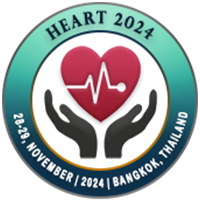
Manal A Ibrahim
Cairo University, EgyptTitle: Valsalva Maneuver in diastolic heart failure, diastolic dysfunction and systolic heart failure clinically BNP and echocardiography
Abstract
Background: Valsalva maneuver one of the oldest method to diagnose heart failure, it’s cheap, noninvasive, bedside tool. Its well studied in systolic heart failure patients which showed abnormal response either squarewave or absent phase IV, however in diastolic heart failure and diastolic dysfunction were not investigated.
Methods: 70 patients were included in our study they were divided into three groups group 1 diastolic heart failure based on echocardiography and BNP above 100pgL/ml, group 2 diastolic dysfunction based on echocardiography and BNP less than 100 pg /ml and group 3 systolic heart failure, they went all clinical examination, BNP were taken, Valsalva maneuver at 30 mmHg for at least 15 sec using two sphygmomanometers first connected to the mouthpiece and the other to monitor blood pressure while the physician auscultates brachial artery patient is asked to perform forced expiratory effort against closed airway for at least 15 second and then asked to release and absence or presence of Korotkoff sounds assessed and heart rate is recorded baseline and after strain and full study echocardiography and using in apical 4 chamber view Simpson method to measure right and left ventricle area at baseline, peak strain and after release.
Results: Group 2 showed overshooting of systolic blood pressure by a mean of 11 6.41mmHg (p-value =0.001), 95% confidence interval (CI): [3.2 15.14] compared to baseline. Moreover, group 3 showed minimal overshooting with a mean of 3.34 4.17mmHg (p-value = 0.002), 95% confidence interval (CI): [2.2 8.2], On the other hand, group 1 showed no overshooting, with a mean change of 3.6 0.63mmHg (p-value = 0.001),95% confidence interval (CI): [9.34 2.5]. We demonstrated that the Valsalva maneuver could differentiate patients with diastolic heart failure from those with diastolic dysfunction, with a sensitivity of 68%, specificity 75%, positive predictive value 71.4%, and negative predictive value 72%. Only group 2 in our study showed a clinically significant decrease in RV end-diastolic area during strain as compared to the baseline, with a mean value of 4.5 0.14 cm2 (23.5 0.4%; p value = 0.001),95% confidence interval (CI):[6.65+2.25]. On the other hand, group 1 showed a minimal decrease (0.9 0.25 cm2; 5.3 0.6%) and group 3 showed a minimal increase(1 2.23 cm2; 5.6 5%). Group 2 showed a clinically significant decrease in LV end-diastolic area during strain as compared to the baseline, with a mean value of 6.1 1.01 cm2 (19.3 2%; p value = 0.001) 95% confidence interval (CI) :[8.2+ 3.96]. Moreover, group 3 showed a smaller, but significant decrease (4.6 0.98 cm2; 12.6 0.7%), while group 1 demonstrated insignificant change.
Conclusion: VM showed significant overshooting in group 2 compared to other two groups, not all heart failure patients had abnormal response based as risk factors as NYHA class and diuretics, stiffness in myocardium affected the Valsalva response in diastolic heart failure group followed by systolic heart failure and finally diastolic dysfunction one. There is decrease in left and right ventricle area during strain and gradually increase after release during normal Valsalva response which is greatly affected in HF patients
Biography
Manal Adel 36y old, Master degree in Cardiology at 2017 , Assistant lecturer in Cardiology department Cairo University Cardiology fellow at Kings College Hospital, London.

